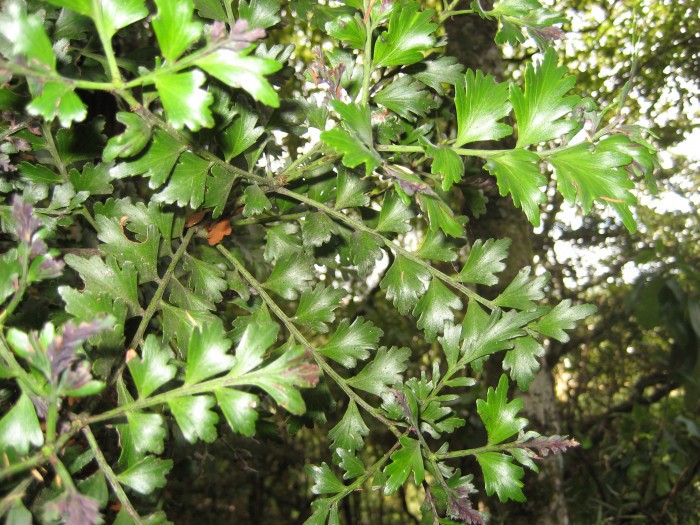Phyllocladus is a small genus of conifers, now usually treated in the family Podocarpaceae. They are morphologically very distinct from the other genera in that family, and some botanists treat them in a family of their own, the Phyllocladaceae. One molecular phylogenetic analysis found Phyllocladus to be sister to Podocarpus sensu stricto. Another was equivocal on its position relative to Podocarpaceae s.s.
Phyllocladus is mainly a southern hemisphere genus, occurring in New Zealand, Tasmania and Malesia, where one species crosses a short way north of the equator in the Philippines.
Description. Celery-top pines are small to medium-size trees, reaching mature heights of 30 to 90 feet (10 - 30 m) tall, or sometimes small shrubs.
- The main structural shoots are green for 2 to 3 years, then turn brown as the bark thickens.
- The leaves are sparse, tiny, scale-like, measuring 0.08 to 0.12 inch (2 - 3 mm) long, and only green (photosynthetic) for a short time, soon turning brown. Most photosynthesis is performed by highly modified, leaf-like short shoots called phylloclades; these develop in the axils of the scale leaves, and are simple or compound (depending on species). Simple phylloclades are rhombic, measuring 0.8 to 2 inches (2 - 5 cm) long, and compound phylloclades are up to 8 inches (20 cm) long and subdivided into 5 to 15 'leaflet'-like phylloclades, each measuring 0.04 to 0.12 inch (1 - 3 cm) long.
- The seed cones are berry-like, similar to those of several other Podocarpaceae genera, notably Halocarpus and Prumnopitys, with a fleshy white aril; the seeds are dispersed by birds, which digest the soft fleshy aril as they pass the hard seeds in their droppings.
The five species are genetically distinct, and probably arose between 5 and 7 million years ago.
- Phyllocladus trichomanoides; Phyllocladus alpinus (P. trichomanoides var. alpinus) - Mountain Toatoa (New Zealand)
- Phyllocladus aspleniifolius - celery-top pine (Tasmania)
- Phyllocladus hypophyllus - Malesian celery pine (New Guinea to Borneo & Philippines)
- Phyllocladus toatoa - Toatoa (New Zealand)
- Phyllocladus trichomanoides - Tanekaha (New Zealand)
